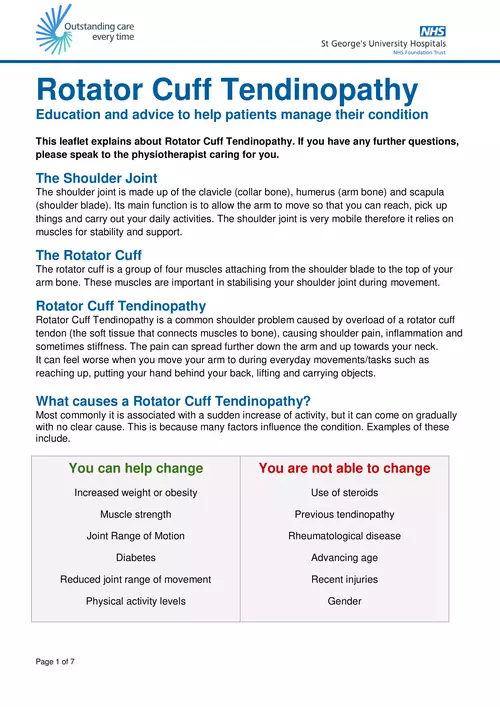
Rotator Cuff Tendinopathy - St George's Hospital
rotator cuff strengthening exercises handout
adsPart of the document
Page 1 of 7
Rotator Cuff Tendinopathy
Education and advice to help patients manage their condition
This leaflet explains about Rotator Cuff Tendinopathy. If you have any further questions,
please speak to the physiotherapist caring for you.
The Shoulder Joint
The shoulder joint is made up of the clavicle (collar bone), humerus (arm bone) and scapula
(shoulder blade). Its main function is to allow the arm to move so that you can reach, pick up
things and carry out your daily activities. The shoulder joint is very mobile therefore it relies on
muscles for stability and support.
The Rotator Cuff
The rotator cuff is a group of four muscles attaching from the shoulder blade to the top of your
arm bone. These muscles are important in stabilising your shoulder joint during movement.
Rotator Cuff Tendinopathy
Rotator Cuff Tendinopathy is a common shoulder problem caused by overload of a rotator cuff
tendon (the soft tissue that connects muscles to bone), causing shoulder pain, inflammation and
sometimes stiffness. The pain can spread further down the arm and up towards your neck.
It can feel worse when you move your arm to during everyday movements/tasks such as
reaching up, putting your hand behind your back, lifting and carrying objects.
What causes a Rotator Cuff Tendinopathy?
Most commonly it is associated with a sudden increase of activity, but it can come on gradually
with no clear cause. This is because many factors influence the condition. Examples of these
include.
You can help change
Increased weight or obesity
Muscle strength
Joint Range of Motion
Diabetes
Reduced joint range of movement
Physical activity levels
You are not able to change
Use of steroids
Previous tendinopathy
Rheumatological disease
Advancing age
Recent injuries
Gender
Page 2 of 7
How do I make my tendinopathy better?
Therapeutic exercises are the best treatment to target the muscles involved. These can improve
likely try a variety of different exercises before finding ones that work for you, because every
tendinopathy responds differently. Discomfort during the exercise is normal but should be
minimal (up to 3/10) and should not flare your symptoms up for the following 24 hours.
Staying active and continuing with general exercise can really help your recovery this will also
have positive effects on your physical and mental health. Remember some physical activity is
better than none.
It is important to reduce activities which are particularly painful to allow your pain to settle down.
It is also important to progressively load your rotator cuff muscles by gradually increasing the
amount of activity you do over time. This will give your body time to adjust, get stronger and
cope with the activities that previously brought you pain.
How long will it take to get better?
You should see some improvement in the first six weeks of physiotherapy however it can take
anywhere between three and 12 months to recover, so patience is important. Timeframes for
recovery depend on a variety of factors including the duration and intensity of your symptoms
and adherence to advice/exercises.
For most people, their symptoms will resolve. Some people will have future flare ups, but these
are less often and better managed thanks to the knowledge and information that they have
previously received.
Remember!
Completing the prescribed exercises for at least three months is the key to
getting better.
Recommended Exercises
At first, performing the exercises may be uncomfortable and you may experience some pain.
If the level of pain is not acceptable to you or persists for longer than half an hour after the
exercise, please reduce the frequency or intensity of the exercises but aim to build this up
gradually over several weeks or months.
Start on the Level 1 exercises. If pain and ability allow, then progress to Level 2 exercises.
Aim to perform the exercises on three to four days of the week.
Page 3 of 7
Level 1 Exercises
Isometric Shoulder External Rotation (aim to perform three rounds of 20 to 30
seconds).


